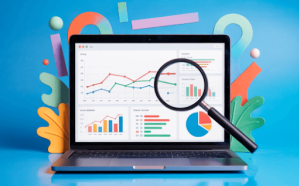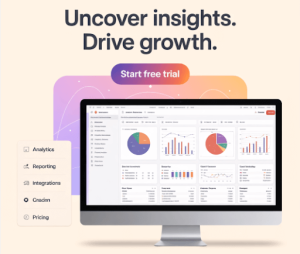If you’re selling on Amazon and feeling overwhelmed by data, you’re not alone. Many sellers miss out on powerful tools simply because they sound too complex. One of those tools is Amazon Brand Analytics (ABA). It’s packed with useful information that can give you a real edge—if you know how to use it.
This guide walks you through Amazon Brand Analytics in plain English. No fluff, no jargon. Just what you need to know to get smarter with your store.
Amazon Brand Analytics Definition: Without the Jargon
Amazon Brand Analytics is a free tool available in Amazon Seller Central for brands enrolled in Brand Registry. It gives you access to reports that show how customers find, view, and buy products.
Think of it like a behind-the-scenes dashboard that tells you what shoppers are doing. What they’re typing. What they’re buying. What your competitors are selling.
In a nutshell, ABA helps you make better decisions based on what people are actually doing on Amazon—not just what you think they’re doing. It’s one of the most important tools in the Amazon brand central suite.
Who Can Access This Tool?
If your brand is enrolled in Amazon Brand Registry, you’re in. You can access Amazon Brand Analytics right from your Seller Central account. If you’re a vendor, you’ll find similar insights through Amazon Vendor Central—often called Amazon vendor analytics.
If you’re not brand-registered yet, you’ll need to take that step first. Only brand owners get access to this specific analytics tool.
Why ABA Is a Must-Have for Every Seller
Over 60% of sales on Amazon now come from third-party sellers. That means you’re competing with thousands of others. Guesswork won’t cut it.
With ABA, you’re not guessing. You’re making choices based on real numbers: what customers are searching for, what they’re clicking on, and what they’re buying instead of your product.

And here’s the kicker: 70% of e-commerce brands will soon rely on real-time analytics to stay ahead. The e-commerce analytics market is expected to hit $25.72 billion in 2025. Data is no longer a luxury. It’s basic survival. This is where tools like Amazon marketing analytics and Amazon business analytics step in.
Key Tools and Reports Inside Amazon Brand Analytics
There are five main reports inside the ABA dashboard. Each one serves a different purpose. Here’s what they are and how they help:
1. Amazon Search Terms Report
This shows you what customers are actually typing into the Amazon search bar. You can see:
- The most popular keywords
- The top 3 clicked products for that keyword
- Click share and conversion share
Use it to figure out what people are searching for and which products are getting the attention. This is the heart of Amazon search analytics and helps improve your product visibility.
2. Market Basket Analysis
This tells you what other products are being bought alongside yours. So if a customer buys your protein powder, ABA might show that they often buy a shaker bottle with it.
That’s your cue to create a bundle or run cross-promotions. These insights are central to any solid Amazon brand analysis strategy.
3. Item Comparison and Alternate Purchase Report
Ever wonder what customers considered before buying? This report shows what items they compared to yours, and which ones they ended up buying.
It’s a reality check. If you’re losing sales to a competitor, this report helps you understand why. It’s a critical piece of Analytics for Amazon sellers.
4. Demographics Report
This one breaks down who your customers are by:
- Age
- Gender
- Household income
- Education
- Marital status
It’s not hyper-detailed, but it helps you understand your customer base better. For Amazon marketplace analytics, the demographics report gives you a clearer picture of your real audience.
5. Repeat Purchase Behavior Report
Do people come back for more? This report tells you how often customers are reordering your products.
If your item is a one-time buy, that’s fine. But if it’s something they should reorder (like supplements or skincare), this tells you if your retention strategy is working. It ties directly into Amazon products analytics.
How to Access the Brand Dashboard
The Brand Dashboard is where all of this lives. Here’s how to find it:
- Log in to Amazon Seller Central.
- Go to “Brands” in the top navigation.
- Click on “Brand Analytics.”
You’ll see the different reports listed. Most of them are downloadable. And the filters are easy to use. Pick your time range, select your ASINs, and you’re good to go.
You can also create your own templates to track ongoing performance. This brand analytics platform is updated regularly with new brand analytics insights.
How to Use ABA to Make Smarter Business Decisions

Let’s break it down into real actions you can take.
Use the Search Terms Report to Find New Keywords
Instead of guessing your PPC keywords, use the Search Terms report to see what people are actually searching. Prioritize those for your campaigns. It’s a better way to handle Amazon site analytics.
Run Bundles Using Market Basket Insights
Find your most common basket pairings and make bundles out of them. This improves cart size and increases customer satisfaction.
Study Alternate Purchases to Beat Competitors
Are shoppers picking a rival brand over yours? Study that ASIN. Look at its reviews, pricing, images, and copy. Then fix what you can. This kind of Amazon ASIN analysis is key to staying competitive.
Tailor Marketing Using Demographics
If most of your buyers are college-educated women in their 30s, your ads and emails should speak directly to that audience.
Track Product Loyalty
See how many customers come back for another round. If your repeat numbers are low, work on packaging, customer experience, and post-purchase follow-up.
What Types of Data Can ABA Report On?
Wondering what kind of geographic info you can actually get from ABA? Here’s the scoop: Amazon Brand Analytics can report on which geographic sales data is trending—yes, down to the states and regions. It gives you a zoomed-in view of where your customers are coming from.
That’s a big deal if you’re planning local promotions, adjusting shipping plans, or deciding where to focus influencer deals. This kind of localized insight from ABA makes it easier to stop guessing and start targeting smarter.
Why ABA Is More Than Just a Tool
Amazon Brand Analytics isn’t just another dashboard. It’s part of a larger shift. Sellers are expected to act more like brands. Not just list products and hope for the best.
If you’re serious about growth, data like this becomes your playbook. It shows you what people want, how they think, and where you can improve.
With Amazon getting more competitive every day, your decisions need to be fast and smart. Tools like this make that possible.
Brand Analytics Tools vs. ABA: What’s the Difference?
ABA is Amazon’s in-house tool. But there are also third-party brand analytics tools and brand analytics software. These often go deeper with visual dashboards, predictive models, or integrations with ad tools.
But here’s the deal: You should start with ABA. It’s free. It’s powerful. And it’s right inside your seller account.
Once you’ve maxed it out, then look into premium tools. Some even tap into the Amazon Brand Analytics API for richer insights.
ABA Keywords and ASIN-Level Analytics
Amazon ASIN analysis is baked right into ABA. You can filter all reports by ASIN and track exactly how each one performs. This is especially useful for:
- Tracking how new products are doing
- Watching seasonal changes
- Spotting underperformers before they drag down your whole catalog
The more you review this ASIN-level data, the smarter your catalog decisions will get.
Using Amazon Analytics Without Feeling Lost
Using analytics Amazon, brand analysis, seller tools—it can all sound too technical. But with a little practice, ABA becomes second nature.
Start small. Pick one report. Play around. Pull data for one product. See what you learn. Then build from there.
You don’t need to be a data expert. You just need to care about what your customer is doing.
Need Help Putting Your Amazon Data to Work?
If reading your reports still feels like decoding another language, you’re not alone. Turning numbers into sales is an art—and that’s where we come in. Manage Amazon offers end-to-end services to make your data actually do something: better listings, stronger ads, smarter branding, and full automation.
From setting up your store the right way to optimizing listings with A+ Content and crafting 3D product visuals that convert, we do the heavy lifting. Whether you’re just starting or scaling up, think of us as your brand analyst Amazon backup—ready to make sense of your numbers and grow your business.
Summary: Why You Should Start Using ABA Now
Here’s a quick recap. Amazon Brand Analytics gives you a look at what shoppers are searching, clicking, and buying. It helps you understand which keywords are working, what your competitors are doing better, and how customers interact with your products. If you’re brand-registered, you can access this tool right inside Seller Central without paying a dime.
The five main reports—Search Terms, Market Basket, Alternate Purchase, Demographics, and Repeat Behavior—let you fine-tune your listings, spot trends, build bundles, and market smarter. At the end of the day, knowing your customers better leads to better decisions. And ABA is one of the easiest ways to get started.



